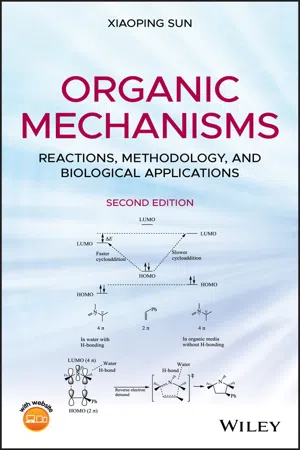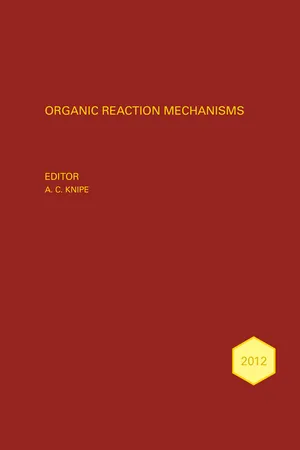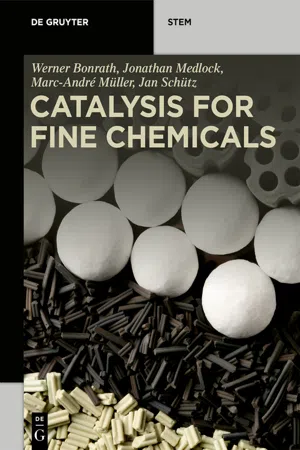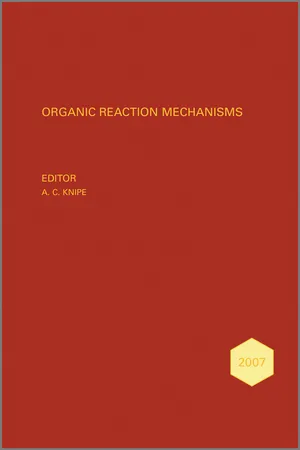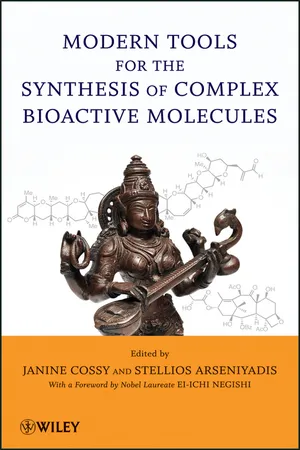Chemistry
Beckmann rearrangement
The Beckmann rearrangement is a chemical reaction that involves the conversion of an oxime to an amide. This reaction is typically carried out using acid catalysts and involves the migration of a carbonyl group from the nitrogen atom to the adjacent carbon atom. The Beckmann rearrangement is an important tool in organic synthesis and is used in the production of a variety of compounds.
Written by Perlego with AI-assistance
Related key terms
5 Key excerpts on "Beckmann rearrangement"
- eBook - ePub
Organic Mechanisms
Reactions, Methodology, and Biological Applications
- Xiaoping Sun(Author)
- 2020(Publication Date)
- Wiley(Publisher)
10.12). The Beckmann rearrangement leads to a ring expansion giving a seven‐membered cyclic nitrilium intermediate. The angular – + C=N– double bond should be the predominately major resonance contributor to the cyclic nitrilium intermediate as a –C≡N + – triple bond in a ring structure would be expected unstable due to the molecular strain. In the next steps, similar to the reaction of an acyclic oxime (Fig. 10.11), the strongly electrophilic carbon in the cyclic nitrilium is attacked by a water molecule, which eventually leads to the formation of caprolactam, a cyclic amide, after proton transfers and a tautomerization. The conversion of oxime of cyclohexanone to caprolactam via Beckmann rearrangement is an industrially useful process, as the caprolactam product is the direct precursor of nylon 6, a versatile polymer that has many applications—among them, the manufacture of fibers for carpeting and other textiles. FIGURE 10.12 Mechanism of Beckmann rearrangement involved in transformation of oxime of cyclohexanone to the cyclic amide caprolactam. 10.3.2 Hofmann Rearrangement In the presence of hydroxide (OH −) and elemental bromine (Br 2), an amide can be converted to an amine with one less carbon atom (Fig. 10.13). Clearly, this conversion involves a 1,2‐rearrangement of the R group in the C─N bond of the amide substrate, called Hofmann rearrangement. The electronegative carbonyl group in the amide can activate its adjacent N─H bond, making the hydrogen slightly acidic. In the presence of the strongly basic OH −, the N─H bond can be deprotonated giving a highly nucleophilic nitrogen anion. Then, the nucleophilic nitrogen anion attacks Br 2, resulting in the introduction of a good leaving group –Br to the amide nitrogen. In the following step, the leaving group –Br and lone pair of electrons in the C–N nitrogen drive a 1,2‐shift of the –R group to make a cationic O=C= + N(H)R intermediate - eBook - ePub
Organic Reaction Mechanisms 2012
An annual survey covering the literature dated January to December 2012
- A. C. Knipe(Author)
- 2015(Publication Date)
- Wiley(Publisher)
164 Beckmann rearrangement Imidazolium-based ionic liquids containing ester moieties in the side chain have been used in the Beckmann rearrangement of ketoximes catalysed by 2,4,6-trichloro[1,3,5]triazine. 214 The X-ray structures of oxime derivatives of cyclohexanone and 4- t -butylcyclohexanone have been reported to show that as the OR group becomes more electron demanding the N–OR bond distance increases and N(1)-C(1)-C(2) bond angle reduces consistent with the early stages of migration of the anperiplanar carbon onto the nitrogen substituent. 215 The synthesis of secondary thioamides from ketoximes via the Beckmann rearrangement has been reported (Scheme 165). 216 Scheme 165 Dimroth Rearrangement The synthesis of an exocyclic 4- β -d-ribofuranosyl-aminoimidazole nucleoside and related 4- N -benzylaminoimidazoles has been reported via a regiospecific and stereoselective base-catalysed Dimroth-type rearrangement of 1-ribofuranosyl and 1-benzyl-5-aminoimidazoles. 217 Favorskii Rearrangement The synthesis of macrocyclic ketones of olfactive interest has been reported using a one-pot Favorskii process with a one-C-atom ring contraction. 218 Friedel–Crafts An intramolecular ipso -Friedel–Crafts-type addition of phenols to 3-alkylidene indolenium cations and formation of iminium cations through rearomatization of the - eBook - ePub
- Werner Bonrath, Jonathan Medlock, Marc-André Müller, Jan Schütz(Authors)
- 2021(Publication Date)
- De Gruyter(Publisher)
7 Rearrangement reactions7.1 Introduction
Rearrangement reactions are a broad class of organic reactions in which the reactant undergoes a rearrangement to give a structural isomer of the original molecule via a migration of an H atom or a larger molecular fragment. From the view of atom economy and E-factor, rearrangement reactions fulfil the criteria of the modern type of chemistry and green chemistry, with all atoms of the starting material being present in the product structure.In many rearrangement reactions, the migration occurs directly to a neighbouring position. These rearrangements belong to the class of [1,2]-rearrangements or [1,2]-shifts. These reactions are often sigmatropic rearrangements meaning that a σ-bond migrates during the reaction. The nomenclature of rearrangement reactions is described by numbering the atoms directly attached to the bond that is broken with 1 and 1ʹ (Scheme 7.1 ). The following atoms in the direction of the rearrangement are labelled 2, 3 and so forth starting from 1 and 2ʹ, 3ʹ and so forth starting from 1ʹ. After the rearrangement the new σ-bond is connected to two atoms which characterise the rearrangement. The numbers are listed in square brackets and the prime is removed from the second number.Scheme 7.1: Naming and examples of sigmatropic rearrangements.Some of the most important industrial rearrangement reactions, such as [3,3]-sigmatropic rearrangements, are used in the synthesis of isoprenoid building blocks such as isophytol, β-ionone or aroma compounds such as methyl heptanone. These are the main focus of this chapter.7.2 Wagner–Meerwein rearrangements
The Wagner–Meerwein rearrangement is a predominately acid-catalysed [1,2]-rearrangement in which a hydrogen, alkyl or aryl group migrates from one carbon to a neighbouring carbon to generate a new carbocation. This carbocation reacts with a nucleophile or a proton from a neighbouring atom is eliminated. The driving force of the reaction is that the initially formed carbocation has the tendency to rearrange to a thermodynamically more stable structure. In the terpene chemistry, the Wagner–Meerwein rearrangement is of importance in the manufacture of camphene from isoborneol (Scheme 7.2 - eBook - ePub
Organic Reaction Mechanisms 2007
An annual survey covering the literature dated January to December 2007
- A. C. Knipe(Author)
- 2011(Publication Date)
- Wiley(Publisher)
The acid-catalysed first step in acidic media and in non-polar solvents is supported by calculations. The acid decreases the enthalpy of the transition state of the second step but the entropy loss overcomes it and the second step is uncatalysed. The two-step mechanism modelled is neutral and concerted and does not include the generally accepted initial protonation of the ketone, but a hydrogen-bonded ketone and acid complex. 11 Beckmann An acetonitrile solution of mercury(II) chloride has been found to catalyse the conversion of acyclic and cyclic ketoximes into their corresponding amides/lactams. 12 Beckmann rearrangement of cyclohexanone oxime in oleum has been reported. A kinetic model which could forecast the relationship between yield and reaction time under different operating conditions has been proposed. 13 A computational study on borderline Beckmann rearrangement–fragmentation reactions shows a single transition state for either the rearrangement or the fragmentation pathway. The reaction path changes from rearrangement to fragmentation when an electron-donating substituent is introduced to the R 1 group, anti to the leaving group. 14 Boulton–Katritzky An experimental investigation of the base-catalysed rearrangement of 3-acylamino-1,2,4-oxadiazoles (7) provided a new one-atom side-chain rearrangement which competes with a ring-degenerate Boulton–Katritzky rearrangement (Scheme 8). The new reaction, which occurs at a higher temperature than the Boulton–Katritzky rearrangement, irreversibly leads to 2-acylamino-1,3,4-oxadiazoles (8) (Scheme 9) - Janine Cossy, Stellios Arseniyadis(Authors)
- 2012(Publication Date)
- Wiley(Publisher)
Chapter 8 Rearrangements in Natural Product Synthesis José Marco-Contelles and Elena Soriano Laboratorio de Química Médica y Computacional, Instituto de Química Orgánica General, Madrid, Spain8.1 Introduction
Molecular rearrangements occupy center stage in the development of organic synthesis [1] and have resulted in various impressive achievements that have been reported in the last decades [2]. Accordingly, the purpose of this chapter is to highlight the use of a set of selected molecular rearrangements and show how these reactions have been utilized as efficient regio-, enantio-, and chemoselective synthetic tools for the preparation of complex bioactives.Our selection has been mainly addressed to pericyclic reactions, among them the [3,3]-sigmatropic rearrangements [3], which continue to provide excellent opportunities for reaching high chemical diversity. In the class of the [3,3]-sigmatropic rearrangements, focus will be on the neutral [3,3]-sigmatropic Cope [4], oxy-Cope/anionic oxy-Cope [5], Claisen [4], and Overman [6] rearrangements, as well as the cationic [3,3]-sigmatropic Petasis–Ferrier [7] and Prins–pinacol [8] rearrangements, and the anionic [1,2]- and [2,3]-sigmatropic Wittig rearrangements [9]. Finally, and in order to complement the selected pericyclic reactions, we will end this chapter with some very well-known propargylic rearrangements, such as the Meyer–Schuster and Rupe rearrangements [10], which are very useful synthetic methods for the transformation of allylic alcohols into α,β-unsaturated carbonyl derivatives. It is worth pointing out that these rearrangements are among the most basic and useful transformations in synthetic organic chemistry. This is due to the fact that these rearrangements are efficient for controlling quaternary, sterically hindered chiral centers and for building carbon–carbon and carbon–heteroatom bonds in a stereoselective fashion. In addition, [3,3]-sigmatropic rearrangements can be easily integrated and adapted in cascade processes as simple methods to prepare complex molecules in atom-economical reactions.
Index pages curate the most relevant extracts from our library of academic textbooks. They’ve been created using an in-house natural language model (NLM), each adding context and meaning to key research topics.
